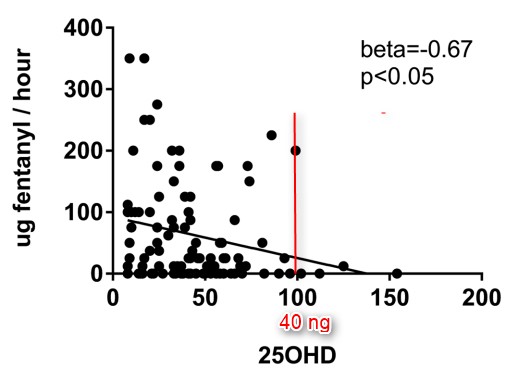Overview Pain and Vitamin D
24+ Vitamin D Life pages have both PAIN and RCT in their title
This list is automatically updated
{LIST()}
Chronic Pain
Chronic Pain reported 38 percent less often if supplemented with Vitamin D – meta-analysis Sept 2016
Chronic pain 40 percent less intense associated with 10 nanogram more vitamin D – April 2014
Is there a role for vitamin D in the treatment of chronic pain – Oct 2014
Following vitamin D intervention less chronic pain and slept better – June 2012
7 improvements in lives of veterans with chronic pain with 50,000 IU vitamin D weekly – June 2012
100 Million Americans Have Chronic pain – IoM June 2011 Good overview of both acute and chronic pain
- Vitamin D Life notices that the majority of the 10 types of pain listed are reduced by increased vitamin D levels
- All items in category Chronic Pain and vitamin D items
Pain sources vs. Vitamin D - Jan 2025

Fibromyalgia and Widespread
Fibromyalgia treated with Vitamin D (50,000 IU weekly for 3 months) – 2016, 2017, 2018, 2019
More likely to have Chronic Widespread pain when have less than 15 ng – May 2010
Vitamin D andChronic Widespread pain for women - who have less vitamin D than men
Rheumatoid Arthritis
Overview Rheumatoid Arthritis and vitamin D RA pain reduction for over 300 years (cod-liver oil)
Headache Pain
- Cluster headaches virtually eliminated in 7,000 people with high-dose vitamin D and cofactors - Feb 2022
- A Cluster Headache is not chronic, but it is very intense
- All items in category Headache and vitamin D items
Dark Skin Pain
150,000 IU vitamin D reduced pain in immigrants – RCT Dec 2012 Dark Skin ==> lower vitamin d ==> more pain
- Dark Skin ==> lower vitamin d ==> more pain
- Sleep disorder and nonspecific pain implies low vitamin D, especially if dark skin – March 2013 Dark Skin ==> lower vitamin d ==> more pain
Other Pain
Does vitamin D treat pain – still not absolutely, positively sure – meta-analysis April 2015
Patients like me survey found vitamin D to be #1 supplement - across ALL problems for pain reduction
Half of seniors with pain had low levels of vitamin D – April 2012
If you cannot get readily get medical treatment consider Alternative Med such as vitamin D
- Might eliminate the pain and occasionally eliminate the need for the medical treatment
Vitamin D reduced skeletal pain in 85 percent of the patients – Nov 2012
Breast Cancer medicine pain reduced with 4300 IU vitamin D – RCT June 2012
RADICAL discussion of vitamin D and Nonspecific Musculoskeletal Pain– Nov 2012 single dose of 150,000 IU 35% reduction
Can vitamin D help with chronic pain? Vitamin D Council March 2013
- one study they discussed: 50,000 IU/week for 2 weeks, 75% reported pain was completely eliminated, full text attached at bottom of this page
- The 25% who still have pain had very little increase in the vitamin D levels in their blood = poor responders.
- see How you might double your response to vitamin D Reasons for low response >26 reasons as of Feb 2013
400,000 IU of vitamin D reduced adult pain and improved quality of life – March 2014
Acute Rehab. patients 2.3X more likely to have musculoskeletal pain if low vitamin D – Oct 2014
Less use of musculoskeletal pain drugs if get vitamin D – Feb 2015
Opioid use in palliative cancer patients far less if high level of vitamin D – May 2015 has the following chart
- Testing your bone pain provides a free vitamin D test with confirmation Feb 2013
- Press with about 10 lbs (4 kg) of force at the bottom of your sternum and your tibia
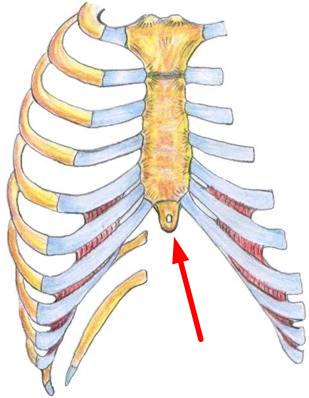
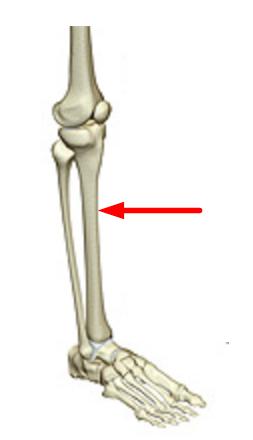
Pain - chronic category has the following
{include}
Items in both of the categories Pain and Intervention:
{category}
Vitamin D Life - Proof that Vitamin D Works (93+)
includes: Back Pain, Raynaud's Pain, Menstrual Pain, Rheumatoid Arthritis, Sickle Cell Pain, Fibromyalgia Knee pain Growing Pain Headache Pain
Note: Many pains are not treated by 1 pill every 2 weeks - they need 1 pill every week
Serious chronic pain list from Institute of Medicine (all helped by Vitamin D)
Migraine and other serious headaches,
Arthritis and other joint pain,
Endometriosis,
Irritable bowel syndrome,
Trauma or postsurgical pain
Lower-back pain,
Shingles,
Sickle-cell disease,
Heart disease (angina),
Cancer,
Stroke
Vitamin D and Chronic Pain - Nov 2013
People with inadequate vitamin D blood levels will need to take twice as much narcotic pain medication as those with adequate vitamin D for pain relief. So, while vitamin D does not cure chronic pain, it is an important adjuvant therapy to use in pain treatment management.
Research studies on vitamin D have shown that many types of fatigue and chronic pain are linked to vitamin D deficiency, including chronic musculoskeletal pain, fibromyalgia syndrome, osteoarthritis, migraine headaches, rheumatic pain and hyperesthesia.
'For patients who do not respond to other therapy, vitamin D supplementation is recommended to alleviate or perhaps even resolve chronic fatigue and pain issues
Vitamin D - A Neglected 'Analgesic' for Chronic Musculoskeletal Pain- An Evidence-Based Review & Clinical Practice Guidance - 2008
Pain-Topics.org 2008, Author: Stewart B. Leavitt, MA, PhD
Medical Reviewers Bruce Hollis, PhD; Michael F. Holick, MD, PhD; Seth I. Kaufman, MD; Lee A. Kral, PharmD, BCPS; Paul W. Lofholm, PharmD, FACA; N. Lee Smith MD; James D. Toombs, MD; Winnie Dawson, RN, BSN, MA
📄 Download the PDF from Vitamin D Life.
Elderly Skin generates less Vitamin D Derived from chart in that study

Pain relievers can extend duration of back pain - and sometimes turning it into a chronic pain - May 2022
Common Medications Can Prolong Back Pain, Study Says New York Times
"Guidelines from professional medical societies already say that people with back pain should start with nondrug treatments like exercise, physical therapy, heat or massage. Those measures turn out to be as effective as pain-suppressing drugs, without the same side effects."
Biobank stiudy found ...2,163 people with acute back pain, 461 of whom went on to have chronic pain. Those taking a nonsteroidal anti-inflammatory had nearly double the chance of developing chronic back pain as those taking other drugs or no drugs, the researchers found.
"An analysis of randomized clinical trials found that these drugs had almost no benefit over placeboes in reducing low back pain."
Study - Acute inflammatory response via neutrophil activation protects against the development of chronic pain 📄 PDF
People in pain having low vitamin D levels will benefit from supplementation - Oct 2017
Vitamin D in Pain Management - review
📄 Download the PDF from Vitamin D Life
See also web
60,000 IU VitaminD monthly was not enough to reduce pain - Nov 2022 📄 PDF
- Mean vitamin D was 30 ng - so half would not be likely to benefit, No indications of % of obese, who need more
One of the Few Pharma Pills I Wholeheartedly Endorse Mercola Nov 2020
- "Low-dose naltrexone, an opiate antagonist, can benefit most autoimmune and chronic pain conditions"
Search Google for "BACK PAIN" VITAMIN D" 1,460,000 hits Sept 2017
Vitamin D Deficiency and Chronic Widespread Pain - June 2017
Google for "Musculoskeletal Pain" "VITAMIN D" 138,000 hits Sept 2017
With a 10-day supply of opioids, 1 in 5 become long-term users March 2017
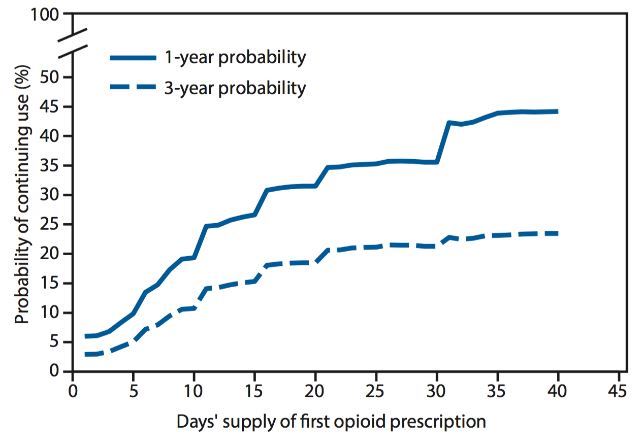
- 2X probability of long-term use if first use was only a 10-day prescription
- Prescription painkillers are more widely used than tobacco, new federal study finds Wash. Post Sept 2016 Nothing about Vitamin D
- "The report indicates that in 2015, more American adults used prescription painkillers than used cigarettes, smokeless tobacco or cigars -- combined"
- ". . opioid painkillers killed nearly 19,000 Americans. That's greater than the total number of Americans (15,809) who were murdered that year"
- " . . when it comes to lobbying, pro-painkiller groups outspend groups arguing for tighter restrictions by more than 200 to 1"
CHRONIC PAIN: WHAT IT IS AND HOW PROPER TESTING HELPS Dec 2020 does not mention Vitamin D
Brief pain summary May 2016
The Opioid Epidemic We Failed to Foresee New York TimesI (Henry Lahore) sent the following comment to NYT
Far less use of opioids if have high level of vitamin D (has chart)
Every single source of chronic pain listed by Institue of Medicine is associated with low Vitamin D
Back pain reduced in 95% of people taking vitamin D - this page
85 Clinical trials listed for Pain reduction with vitamin D - this page
Chronic Widespread Pain associated with Vitamin D under 10 ng
WOMEN'S PAIN IS DIFFERENT FROM MEN'S—THE DRUGS COULD BE TOO Wired Mag March 2019
Nothing about Vitamin D. Virtually all pain research has been on maile animals
Mercola Review of Acupuncture for pain relief Aug 2017 nothing about vitamin D
2002 WHO review
2004 of 29 studies found 50% reduction in pain levels
Recent acupuncture study discovered Nitric Oxide (NO) at the points
Alternatives to Drugs for Treating Pain NYT Sept 2017
Pain of headaches, back, sciatica, etc, are sometimes due to muscle tension.
Reducing the muscle tension thru relaxation (meditation, yoga, etc) often help
The article references include
- "Noninvasive Treatments for Acute, Subacute, and Chronic Low Back Pain: A Clinical Practice Guideline From the American College of Physicians" - April 2017 full text online
- "Evidence-Based Evaluation of Complementary Health Approaches for Pain Management in the United States" May 2016 free PDF on-line
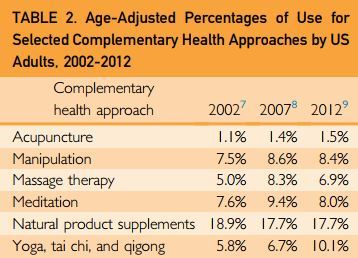

Personal note: They do not seem to mention additional ways I have found to eliminate various pains in 10 minutes.
Muscle exercise using Bow Flex exercise machine
Pain Factoids from the Body by Bill Bryson, 2019
Chronic pain has no purpose. It’s just a system gone wrong, in the same way that cancer is a system gone wrong. We now believe that many types of chronic pain are diseases in their own right, something quite separate from acute pain.”
The International Classification of Headache Disorders recognizes fourteen categories of headaches—migraine, trauma-induced headache, infection-induced headache, disorder of homeostasis, and so on.
According to the U.S. Institute of Medicine, part of the National Academy of Sciences, about 40 percent of adult Americans—100 million people—are experiencing chronic pain at any given moment.
Altogether chronic pain affects more people than cancer, heart disease, and diabetes combined.
Andrew Rice, a pain researcher at Imperial College London, told Nature in 2016, “The drugs we have relieve 50 percent of pain in somewhere between one in four and one in seven of the patients we treat. That’s for the best drugs.” In other words, some 75 percent to 85 percent of people get no benefit at all from even the best pain drugs, and those who do get benefit don’t usually get much.
Pain is associated with other categories: Intervention, 33, Osteoarthritis 9, Loading dose 7, Skin - Dark 7, Magnesium 7, Seniors 7, Sleep,7, etc
Back pain, 6, Cancer - after diagnosis, 5, Osteoporosis, 5 (as of Nov 2023)
Close Associations
Short URL for this page = http://is.gd/painvitamind

